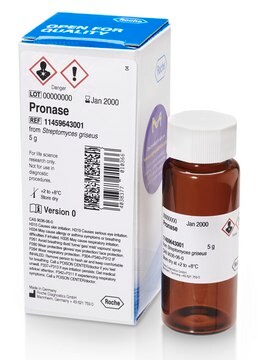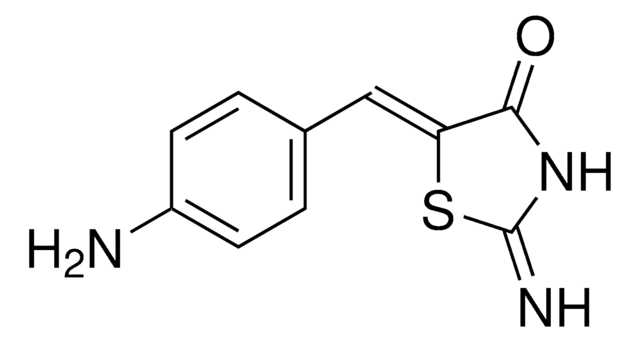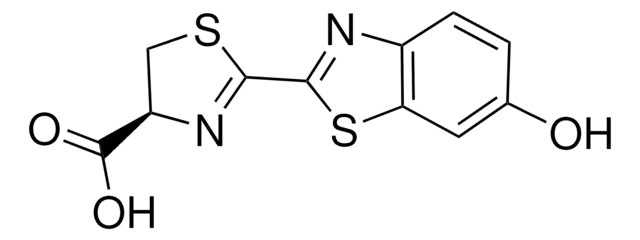SRP2030
Sp1 GC-box binding protein human
recombinant, expressed in insect cells, ≥75% (SDS-PAGE)
Sign Into View Organizational & Contract Pricing
All Photos(1)
About This Item
UNSPSC Code:
12352202
NACRES:
NA.26
Recommended Products
biological source
human
recombinant
expressed in insect cells
Assay
≥75% (SDS-PAGE)
form
frozen liquid
mol wt
~81.6 kDa
packaging
pkg of 5 μg
storage condition
avoid repeated freeze/thaw cycles
concentration
200 μg/mL
technique(s)
electrophoretic mobility shift assay: suitable
color
clear colorless
NCBI accession no.
UniProt accession no.
shipped in
dry ice
storage temp.
−70°C
Gene Information
human ... SP1(6667)
Application
Sp1 transcription factor has been used as a standard in electrophoretic mobility shift assay.
Biochem/physiol Actions
Sp1 was first detected in HeLa cells on the basis of its ability to activate the SV40 early promoter transcription. Subsequently it was shown to recognize and bind selectively to a GC-rich consensus sequence (GC-box: GGGCGG or CACCC) that presents in the promoter of several important cellular genes, including SV40 early, HIV-1, PDGF-B etc. Sp1 was the first transcription factor to be cloned and characterized. Analysis of structure and function has revealed that Sp1 can be separated into discrete functional domains. The DNA-binding domain consists of three zinc fingers that specifically bind to the GC-box element. Sp1 contains at least four separate transcriptional activation domains. Two of these domains are glutamine-rich, a well-characterized motif found in several other transcription factors. In addition to transcription, Sp1 function has been linked to cell growth, cancer, Huntington disease and other disorders through transcriptional regulation or specific protein-protein interactions. The function of Sp1 can be regulated by phosphorylation and glycosylation.
Physical form
Clear and colorless frozen liquid solution
Preparation Note
Use a manual defrost freezer and avoid repeated freeze-thaw cycles. While working, please keep sample on ice.
Storage Class Code
10 - Combustible liquids
WGK
WGK 1
Flash Point(F)
Not applicable
Flash Point(C)
Not applicable
Choose from one of the most recent versions:
Certificates of Analysis (COA)
Lot/Batch Number
Don't see the Right Version?
If you require a particular version, you can look up a specific certificate by the Lot or Batch number.
Already Own This Product?
Find documentation for the products that you have recently purchased in the Document Library.
M R Briggs et al.
Science (New York, N.Y.), 234(4772), 47-52 (1986-10-03)
The biochemical analysis of cellular trans-activators involved in promoter recognition provides an important step toward understanding the mechanisms of gene expression in animal cells. The promoter selective transcription factor, Sp1, has been purified from human cells to more than 95
W S Dynan et al.
Cell, 35(1), 79-87 (1983-11-01)
Fractionation of HeLa cell extracts reveals the presence of a promoter-specific transcription factor, Sp 1, which activates a class of promoters that includes the SV40 early promoter but not several others that have been tested. We analyzed SV40 early-promoter deletion
Alexandra Jaeger et al.
International journal of biological sciences, 11(9), 1006-1015 (2015-07-30)
The beta-2 adrenergic receptor (beta-2 AR) modulates metabolic processes in skeletal muscle, liver, and adipose tissue in response to catecholamine stimulation. We showed previously that expression of the porcine beta-2 AR gene (ADRB2) is affected by cis-regulatory polymorphisms. These are
Our team of scientists has experience in all areas of research including Life Science, Material Science, Chemical Synthesis, Chromatography, Analytical and many others.
Contact Technical Service








